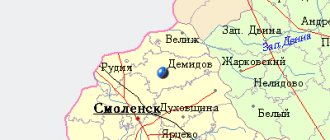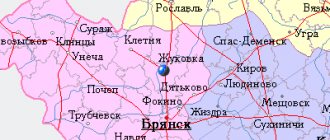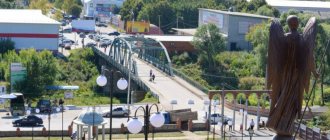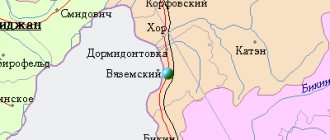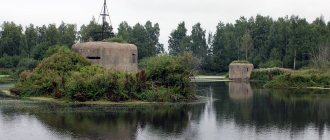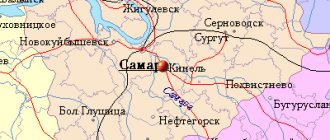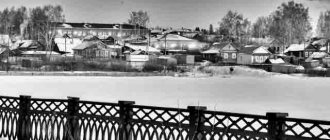District in Tver region, Russia
| Konakovsky district Konakovsky district | |
| District | |
| Sewing factory in the town of Kozlovo, Konakovo district. | |
| Flag Coat of arms | |
| Location of Konakovsky district of Tver region | |
| Coordinates: 56°42'N 36°47'E / 56.700°N Latitude 36.783°E / 56,700; 36.783 Coordinates: 56°42'N 36°47'E. / 56.700°N Latitude 36.783°E / 56,700; 36,783 | |
| A country | Russia |
| Federal subject | Tver region [1] |
| Administrative center | Konakovo [1] |
| Square [2] | |
| • General | 2,114 km 2 (816 sq mi) |
| population size (2010 Census) [3] | |
| • General | 87 125 |
| • Evaluate (2018) [4] | 81 147 ( -6,9% ) |
| • Density | 41/km2 (110/sq mi) |
| • Urban | 77,7% |
| • Rural | 22,3% |
| Administrative structure | |
| • Administrative division | 1 Urban settlements (cities), 5 Urban settlements (urban-type settlements), 10 Rural settlements |
| • Settlements | 1 Cities, 5 Urban settlements [5], 181 Rural settlements |
| Municipal structure | |
| • Municipally registered as | Konakovsky municipal district [6] |
| • Municipalities [7] | 6 urban settlements, 10 rural settlements |
| Timezone | UTC+3 (MSK[8]) |
| OKTMO ID | 28630000 |
| Web site | https://konakovoregion.ru/ |
Konakovsky district
(Russian: Konakovskiy raion) is an administrative [1] and municipal [6] district (district), one of thirty-six in the Tver region, Russia. It is located in the south-eastern part of the region and borders the Kimry district in the north-east, in the city of Dubno, Moscow region, in the east, Dmitrovsky district of the Moscow region in the south-east, Klinsky district of the Moscow region in the south, Lotoshinsky district of the Moscow region in the south- in the west and the Kalininsky district in the north-west. The area of the district is 2,114 square kilometers (816 sq mi). [2] Its administrative center is the city of Konakovo. [1] Population: 87,125 (2010 census); [3] 49,692 (2002 census); [9] 55,101 (1989 census). [10] The population of Konakovo is 47.4% of the total population of the district. [3]
History[edit]
Dmitry Medvedev and Raul Castro in Zavidovo.
Since the 13th century, the territory was part of the Tver Principality. [11] In the 18th century, the eastern part of the district was included in the Moscow Governorate. In 1775 it was transferred to the newly formed Tver governorship, and from 1781 it became part of the Korchevsky district. [11] In 1796, the governorship was abolished and transformed into the Tver Governorate. [12] The district center was in the city of Korcheva, located on the territory of the current district. [11] On May 30, 1922, Korchevsky district was abolished and annexed to Kimry district.[13]
The western part of the region belonged to the Klinsky district of the Moscow province. [14]
On July 12, 1929, the Moscow and Tver provinces were abolished, and the territory was transferred to the Moscow Region. [13] The counties were abolished, and the Kuznetsovsky district, with its administrative center in the city of Korchev, was created in the Kimry district in the Moscow region. [15] On July 23, 1930, the districts were abolished, and the districts were directly subordinated to the region. February 26, 1930 town. Kuznetsovo was renamed Konakovo, and Kuznetsovsky district - Konakovsky. [13] On January 29, 1935, the Kalinin region was formed, and the Konakovsky district was transferred to the Kalinin region. In 1937, when the Ivankovskoye reservoir was filled, Korcheva plunged into the water. The administrative center of the district was transferred to Konakovo, which was given the status of a city. [11] [15] In 1941, during World War II, the western part of the area was occupied by German troops. On February 13, 1963, during the failed Khrushchev administrative reform, the Konakovsky district was merged with the Kalininsky district, but on January 12, 1965 it was restored. [13] In 1990, the Kalinin region was renamed the Tver region.
On July 12, 1929, the Zavidovsky district was formed with the administrative center in the town of Novozavidovsky. It was part of the Tver district of the Moscow region. On July 1, 1936 he was transferred to the Kalinin region. On November 14, 1960, the district was abolished and annexed to the Konakovsky district. [13]
On September 8, 1937, the Orshinsky district with the administrative center in Selo from Rozhdestvena was created in the area that previously belonged to the Konakovo and Zavidovo districts. On October 22, 1959, the district was abolished and divided into Konakovsky, Kalininsky and Goritsky districts. [13]
In Zavidovo, in the 1960s, a hunting ground was created for VIPs, including heads of state. Since 1996, Zavidovo has the status of one of the official residences of the President of Russia.
Economics [edit]
Konakovskaya GRES - thermal power plant - the largest enterprise in the region. In 2008, it produced more than 60% of the district's GDP. [16]
Industry[edit]
The district is industrially developed and ranks third in the Tver region in terms of industrial production after Tver and the Udomelsky district. Among the large enterprises is a mechanical plant for cranes and specialized trucks in the village. Novozavidovsky and the construction industry plant in the town. Isoplit. [16]
Agriculture[edit]
The main specializations of the district's agriculture are livestock farming with the production of meat and milk, poultry farming, vegetable growing, fur farming, fish farming and fishing. [16]
Transport[edit]
Railway station Konakovsky Mokh.
The Moscow - St. Petersburg railway crosses the region from south to north. In particular, it crosses the Ivankovskoye Reservoir through a dam. The main stations in the area are Zavidovo (in the town of Novozavidovsky) and Redkino. All stops on this line within the district are on the Leningrad Suburban Railway and are connected by regular passenger commuter services to both Moscow (Moscow, Leningradsky Station) and Tver. In addition, a railway line branches off to Konakovo in Reshetnikovo. Konakovo (Konakovskaya GRES) is also connected by regular passenger commuter services to Moscow.
The M10 highway, connecting Moscow and St. Petersburg, crosses the area from southeast to northwest. At Zavidovo the road branches east and leads to Konakovo and Kimry. There are also local roads with bus service.
Culture and recreation[edit]
The Church of the Nativity of the Blessed Virgin Mary in Gorodnya (c. 1340) is the oldest building in the Tver region.
In the area there are four cultural heritage monuments of federal significance and an additional 81 objects classified as cultural and historical heritage of local significance (eight of them are located in Konakovo). Federal monuments are the ensemble of the Travel Palace and the Church of the Nativity of the Virgin in Selo in Gorodnya, the Poroshin House in Selo in Zavidovo, as well as a monument in honor of the Kalinin Front active during World War II. [17]
The Konakovo District Museum, located in Konakovo, has exhibitions on the archeology and history of the region. [18] The Spiridon Drozhzhin Memorial Museum was opened in the village. Novozavidovsky. The house in which this house was built by the poet Drozhzhin, who lived in the 19th and early 20th centuries, in the village of Nizovka, which was later flooded with water during the construction of the Ivankovsky reservoir. The house was transferred to Novozavidovsky and opened as a museum. It was significantly damaged during World War II and later restored. Currently, Drozhzhin's personal belongings are on display here and an exhibition dedicated to his life is presented. [19]
Konakovsky district is located in the south-eastern part of the Tver region, 100 km from the Russian capital. The length of the region from north to south is 36 km, from west to east - 57 km. It is located next to the railway and highways (Moscow - St. Petersburg), as well as on the waterway (Volzhsky). The area of the Konakovsky district is 2114 sq. km. The population is 98.2 thousand people, including rural - 20.2 thousand people, urban - 78 thousand people. 44.6 thousand people live in the city of Konakovo, 33.4 thousand people live in urban-type workers' settlements. On the territory of the district is the famous Zavidovo - the residence of the head of our state “Rus”. Konakovsky district has high potential in the field of tourism development. Picturesque places, the beauty of the Ivankovo reservoir, the Volga River and many small rivers, forests, the wealth of nature, the presence of monuments of ancient Russian culture - all this attracts numerous tourists to us. The names of many historical cultural and scientific figures are associated with the area. Konakovsky district occupies a favorable geographical position at the intersection of international and domestic transport routes - railway, road, water. A significant part of the roads and railways connecting Moscow and St. Petersburg pass through the Konakovsky district, which makes it possible to evaluate tourism as a “weekend holiday” for these cities. In terms of its geographical location and climate, the area fully represents typical Russian nature, which contributes to the interest of tourists, especially foreign ones living in Moscow. Thanks to the abundance of reservoirs, the area has rich fish resources, which is a good base for organizing water tourism with licensed and recreational fishing. The vast fauna allows hunting tourism to develop. The diverse landscape and richness of nature make it possible to lay a variety of routes throughout the area - walking, cycling, driving, horseback riding, skiing and others. Konakovo land, regardless of the time of year, is a place of real pilgrimage for tourists from all over the country. It is no coincidence that tourism was chosen as one of the priority areas for the development of the region.Fans of extreme sports can take part in kiting competitions, snowmobile racing, motocross, and car rallying. In addition, every summer in our area there is an equestrian festival - competitions for the Zavidovo Cup, and a truly breathtaking spectacle is the Upper Volga sailing regatta for the prize of the governor of the Tver region, which attracts a huge number of yachtsmen. The Volga River with its picturesque banks and pine forests, the latitude of the Ivankovo Reservoir are excellent conditions for the development of water tourism. There are several yacht clubs in the area. Having visited Konakovo once, you will never forget the quiet splash of water, watercolor sunsets, or a warm breeze with the smell of pine needles. In a word, active life is in full swing on the Konakovo land (and on the water) all year round. If the best vacation for you is traditional excursions with sightseeing, you are welcome to Konakovo! It is here that the legendary Kuznetsov’s earthenware factory is located, founded back in 1809 (now – OJSC Konakovo Earthenware Factory). There is a museum on the territory of the KFZ, where you can see dishes from the “tsarist” times, and a service intended as a gift to Stalin, and samples of modern products. And the local history museum has a unique collection of antique watches, which was donated to the city by one of the local residents.
Konakovo has all the conditions to receive and develop medical tourism. The area has the necessary infrastructure: a health resort, a state district power station dispensary, plus a lot of areas for the construction of appropriate facilities where it would be possible to combine recreation with modern diagnostics and treatment of the body. Konakov residents are proud of their city, its history, and the unique nature of the Upper Volga region. All conditions for cultural leisure and recreation of people have been created here. Konakovsky district has a rich historical and cultural heritage. In 1999, the earthenware factory, founded in 1809 by the Bohemian pharmacist Friedrich Christian Brynner, celebrated its 190th anniversary. Since 1829, it began to belong to the Auerbach family of Russian landowners. In 1869, the plant was bought by the largest magnate of the porcelain and earthenware industry, Matvey Sidorovich Kuznetsov, “the king of Russian porcelain.” The oldest building of the plant - the 7th forge - a workshop for unique and low-volume products, built in 1883, is a historical monument. The products of the earthenware factory are widely known not only in our country, but also in dozens of countries around the world. In 1937, at the World Exhibition in Paris, the plant was awarded the highest award, the Grand Prix, for the high quality of its products and its original artistic design. These labor traditions continue to this day. A whole galaxy of art luminaries - talented artists and sculptors, awarded for their high level of creative skill with the country's highest awards - have worked and are working in the factory's art laboratory. Some of the best examples of products are exhibited as outstanding works of art in the State Historical Museum in Moscow, the Russian Museum in St. Petersburg, and the Museum of Ceramics in Kuskovo. The plant's storage museum currently displays not only modern products, but also exhibits from Kuznetsov's times. In a pine forest (within the city) at the confluence of the Donkhovka River and the Volga on the shore there is a dacha (complex) by the architect Gautier, built at the end of the 19th - beginning of the 20th century. This estate is an architectural monument. In the old part of the city, on the left bank of the Donkhovka River, there is an unusual building of original architecture. It was erected in the period from 1907 to 1912, when new buildings were being built at the Tver Porcelain and Earthenware Factory (now JSC Konakovo Faience Factory). Engineer N.A. Loturaev, who represented the construction industry in the village of Kuznetsov, designed and supervised the construction of the building. This company carried out the construction of new buildings of the Tver porcelain and earthenware factory of the M.S. Kuznetsov Partnership. An interesting technical innovation was used during the construction of the building. The masonry of the walls is made of unfired (gray concrete) bricks, which were made from unused daytime remains of the concrete mixture used in the construction of factory buildings. The decision to construct this building, which was specifically intended for the electric theater “Kinematograf”—as cinemas were called at that time—was made with the aim of making more complete use of the concrete solution. The resulting building bricks from concrete mortar with gravel were used for masonry inside the walls. For facing masonry, a special brick was made from a solution of Portland cement and sifted river sand. Unfired brick can be considered the predecessor of modern silicate autoclave brick. The architecture of the building corresponds to the trends characteristic of the period of decline of Russian Art Nouveau. This is the eclecticism of forms, the asymmetry of the building elements, the use of various towers and lancet superstructures over the dormer windows and in other elements of the building, and at the same time the use of original structural elements made of reinforced concrete, including the staircase between floors in the main tower, the ceiling of the semi-basement foyer under the auditorium and others. The Kuznetsovsky cinema was the only one in the entire Korchev district and one of the first provincial cinemas in Russia opened in a building specially built for this purpose. For a remote factory village, this event was very significant, because... not only in the district center of Korchevo, but even in other large cities of Russia there were no cinemas, so Korchevo residents often came to Kuznetsovo to see the “miracle of the 20th century.” The auditorium was designed for 350-400 seats. Silent films were shown here, accompanied by music. Two local musicians played piano and violin. One or two breaks were taken during the sessions. At this time in the summer, spectators went out into the street, listened to the music of the brass band, and danced. The orchestra specially came from Korcheva. The first Soviet color film “Grunya Konakova” (“Nightingale the Nightingale”), shot in Konakovo, was shown here for the first time. In military campaigns against the Tatar-Mongol conquerors, the Karachar brothers, Methodius and Ambrose, Tatars by origin, distinguished themselves among other military leaders. For faithful service and diligence, the Grand Duke of Moscow and All Rus' awarded them land in the upper reaches of the Volga from the recently annexed Tver lands and villages. Thus, at the end of the 15th century, the new Karacharovo estate arose. The descendants of the Russified brothers owned this land until the middle of the 18th century. After this, the Karacharov family ceased to exist. The estate passed from hand to hand for almost a century, until in 1858 it became the property of a famous public figure, a prominent Russian painter, architect, lithographer, art researcher, and philanthropist Prince G.G. Gagarin. He was vice-president of the St. Petersburg Academy of Arts from 1859 to 1872. Grigory Grigorievich was a close friend of M.Yu. Lermontov, familiar with A.S. Pushkin, and illustrated their works. “An artist not by title, but by vocation” - this is how V.G. Belinsky spoke about him. Gagarin became friends with Lermontov and entered the circle of young people close to the poet (the circle of sixteen) in 1839. In 1840 Lermontov was exiled to the Caucasus and Gagarin is going there too. He takes part in military campaigns as an amateur artist. His study of the life and art of the peoples of the Caucasus is reflected in the album “Picturesque Caucasus”. The battle paintings “The Battle of Akhatli” (1841), “The Meeting of General Klunke von Klugenau with Shamil” (1849), “The White Key” are true and realistic. The main apartment of the Mingrelian regiment", "Karagach. Main apartment of the Nizhny Novgorod regiment." He illustrated pages of works by A.S. Pushkin: “The Tale of Tsar Saltan”, the poem “Ruslan and Lyudmila”, “Hussar”, “The Queen of Spades”. G.G. Gagarin was a student of the artist K.P. Bryullov. Over two thousand watercolors, paintings and drawings - this is the creative legacy of this talented and multifaceted artistic figure before Russian culture. His works are exhibited and stored in the collections of the Russian Museum (Bryullov Hall) in St. Petersburg, the A.S. Pushkin Museum on Arbat and in the Tretyakov Gallery in Moscow, Tver Art Gallery...
G.G. Gagarin was born in 1810. in St. Petersburg, and died in 1893. in France, but bequeathed to be buried in Karacharovo, where he always lived for a long time and which he loved very much. During his life in Karacharovo, G.G. Gagarin significantly changed the layout of the estate. Instead of wooden buildings, stone one- and two-story buildings were erected. The house in which the Gagarin family lived has been preserved - a two-story house built in the style of Italian villas. There is a memorial plaque on it dedicated to the memory of the artist. A grotto has also been preserved, shaped like the family’s favorite dog, Polly, and the inscription: “Her devotion was boundless.” Karacharov’s pride is a large picturesque park with an area of 66 hectares. It is laid out on the model of London's Hyde Park. For this, Gagarin invited gardeners from London. The layout of the park is unique and interesting. There are 8 alleys diametrically diverging from the center, each of which has “its own face”, i.e. consists of certain types of trees. There is an alley of pine, spruce, oak, maple, aspen, birch, linden and ash. In total, there are 50 alleys and alleys in this park. Each of the alleys ended with a surprise. Flower beds of roses, benches, gazebos, and swings decorated these alleys. One of the alleys leads to a pond with an openwork bridge across it. The ashes of G.G. Gagarin were transported to Karacharovo and buried in the former rural cemetery. A modest monument has been erected at the grave, located on the outskirts of the park. The park gradually turns into virgin forest. Considering the historical and artistic significance and uniqueness of this park, which has preserved the layout of a regular park of the 18th century (laid out in 1861-63), its territory and the adjacent massif of about 500 hectares have been declared a natural reserve.
Karacharovo is not only a historical monument, but also one of the literary places, because associated with the names of famous writers. In 1952, the famous Russian writer Ivan Sergeevich Sokolov-Mikitiv (1892-1975) settled here for the first time in the summer season. Already in the 20s, his name was put on a par with such nature-loving writers as M.M. Prishvin, K.G. Paustovsky. Sokolov-Mikitov's literary work is varied, colorful, unusual, and truthful. His collections are interesting: “On the Liberated Land”, “Kuzovok”, “On the Warm Land”, collections about Taimyr, a whole series of essays, short stories, novellas. In 1974, two collections of the writer: “The Voice of the Earth” and “Sounds in the Forest” in Leipzig received first prize and diplomas for the best description of nature. It is estimated that in Karacharovo Ivan Sergeevich wrote 25 books, i.e. more than one book for every year I lived here. A.T. Tvardovsky, K.A. Fedin, V.A. Soloukhin came to visit him. In 1981, a memorial plaque was installed on the house where I.S. Sokolov-Mikitov lived. The American writer, author of the book “Ten Days That Shook the World,” John Reed, visited Karacharovo. In the village of Novozavidovsky there is a literary and memorial house-museum of the talented peasant poet-nugget Spiridon Dmitrievich Drozhzhin (1848-1930). Drozhzhin is a prominent Russian poet of the Tver land, one of the galaxy of writers of the Nekrasov movement. His creative activity lasted more than half a century. The life of the Russian village at the end of the 19th and beginning of the 20th centuries, pictures of peasant labor and life, the beauty of his native Upper Volga region are his poetic passions. Marked by a bright individuality, the poet’s work finds a lively response in the hearts of people today. A small wooden house on one of the streets of the village is marked with a marble memorial plaque with the text: “The poet-peasant S.D. Drozhzhin lived in this house in 1896-1980.” In front of the house, next to the grave, a monument to the poet was erected - a sculpture of S.D. Drozhzhin by E.A. Antonov, who depicted a creatively inspired poet. S.D. Drozhzhin lived a long, difficult, but creatively rich and integral life. He was lucky enough to meet the most brilliant people of the era: L.N. Tolstoy, I.A. Bunin, A.M. Gorky, S.A. Yesenin. The poet's house-museum preserves his creative heritage and relics. Everything here is as it was during the life of Spiridon Dmitrievich. Within these walls he prepared most of the collections of his works for publication. Books with dedicatory inscriptions by L.N. Tolstoy, A.S. Serafimovich, F.V. Gladkov, N.D. Teleshov, P.N. Sakulin, and the American writer A.R. Williams are kept here. This house hospitably welcomed the poet N.N. Zlatovratsky and the writer-translator I.A. Belousov, the German poet Rainer Rilke and the Finnish poet Yalmari Virtanen, the writer B.N. Polevoy and many Tver writers. The museum gives a lot for understanding the world of Drozhzhin. The opening of the house-museum took place in May 1938, and since 1978 it has become a branch of the Tver State United Historical, Architectural and Literary Museum. The museum is called “a unique, little preserved corner of Russian life,” “living peasant history” and “a monument to everything eternal, bright, and good.” Thousands of guests come here every year from all over the country to admire this wonderful talent. The folk trail to the poet’s abode does not become overgrown.
The local poet Nikolai Strelnikov said it beautifully: “...Some rush to the remains of the Colosseum, In the billiard room there is no end to others. And I am in the silence of the hut-museum, In which the Poet lived, suffered and sang.”
In the village of Redkino the house of the artist, “academician from the peasantry” Ivan Ivanovich Tvorozhnikov (I848-I9I9) is preserved. He was born into a family of serfs, at the age of 12 he was sent to St. Petersburg to earn money, studied at the school of the Society for the Encouragement of Arts and at the Academy of Arts (1868-1875), and taught there since 1895. (since 1898 - professor). Tvorozhnikov was a talented painter, was a full member of the St. Petersburg Academy of Arts (since 1906), and participated in the design of St. Isaac's Cathedral. The main theme of Tvorozhnikov’s paintings is the difficult working life of the people, the peasant lot. On the house in which before I860. Tvorozhnikov lived and visited several times later, coming to sketches in 1974. a memorial plaque was installed. Our region is of significant importance and plays a significant role in the history of the Tver Upper Volga region and its modern life. The ancient Korchev land has always been famous for its patriots who sought to preserve its history and culture and increase its spiritual values.
Links[edit]
Notes[edit]
- ^ abcd State Committee of the Russian Federation on Statistics. Committee of the Russian Federation for Standardization, Metrology and Certification. No. OK 019-95 January 1, 1997 “All-Russian classifier of objects of administrative-territorial division. Code 28 230", ed. changes No. 278 / 2015 dated January 1, 2016. (Goskomstat of the Russian Federation. Committee of the Russian Federation for Standardization, Metrology and Certification. No. OK 019-95 January 1, 1997. Russian classification of administrative divisions) (OKATO).
Code 28 230 , as amended by Amendment No. 278/2015 of 01/01/2016). - ^ ab “Archive copy” Geographical location (in Russian). Administration of Konakovsky district. Archived from the original on August 19, 2014. Retrieved 19 August 2014.CS1 maint: archived copy as title (link)
- ^ abc Federal State Statistics Service (2011). “All-Russian Population Census 2010. Volume 1" [All-Russian Population Census 2010, vol. 1]. All-Russian Population Census 2010 [All-Russian Population Census 2010]
. Federal State Statistics Service. - "26. The size of the permanent population of the Russian Federation by municipalities as of January 1, 2022". Federal State Statistics Service. Retrieved January 23, 2022.
- Urban-type settlements may include workers' settlements, resort settlements, holiday villages, as well as urban-type settlements themselves.
- ^ ab Law No. 4-ZO
- Law No. 31-ZO
- "On the Calculation of Time". Official Internet portal of legal information
. June 3, 2011. Retrieved January 19, 2022. - ↑
Federal State Statistics Service of Russia (May 21, 2004).
“The population of Russia, the constituent entities of the Russian Federation as part of federal districts, urban settlements, settlements, settlements of 3 thousand or more people” [Population of Russia, its federal districts, federal districts, districts, urban settlements, rural settlements - administrative centers and rural settlements with a population of more than 3,000 people] (XLS). All-Russian Population Census 2002
. - “All-Union Population Census of 1989. The current population of union and autonomous republics, autonomous regions and districts, territories, negative phenomena, urban settlements and rural district centers” [All-Union Population Census of 1989: current population of union and autonomous republics, Autonomous regions and districts , territories, regions, districts, towns and villages performing the functions of district administrative centers. All-Union Population Census of 1989 [All-Union Population Census of 1989]
.
Institute of Demography of the National Research University: Higher School of Economics [Institute of Demography of the National Research University: Higher School of Economics]. 1989 - via Demoscope Weekly
. - ^ a b c d About the area (in Russian). Konakovo district administration. Retrieved August 26, 2014.
- Russian Empire: administrative-territorial division (1708–1917): Tver Governorate (in Russian). Russian National Library. Retrieved July 12, 2013.
- ^ a b c d e Information on changes in the administrative-territorial division of the Tver region - Kalinin region (in Russian). Archives of Russia. Archived from the original on April 19, 2012. Retrieved July 11, 2013.
- Petropavlovsky, B.I. “Archival copy” Konakovo and Konakovsky district (in Russian). Tver Regional Library. Archived from the original on January 21, 2012. Retrieved September 13, 2014.CS1 maint: archived copy as title (link)
- ^ a b History of the city of Konakovo (in Russian). Website of the Konakovo administration. Retrieved August 27, 2014.
- ^ a b c Socio-economic situation (in Russian). Konakovo district administration. Retrieved August 25, 2014.
- Monuments of history and culture of the peoples of the Russian Federation (in Russian). Ministry of Culture of Russia. Retrieved June 2, 2016.
- Konakovo Museum of Local Lore (in Russian). Russian Cultural Heritage Network. Retrieved August 21, 2014.
- House-Museum of S.D. Drozhzhin (in Russian). Russian Cultural Heritage Network. Retrieved August 21, 2014.
Kozlovskoye rural settlement
On the beginning of declaration reporting on the volume of retail sales of alcoholic and alcohol-containing products, beer and beer drinks, cider, poire and mead for the fourth quarter of 2022 from 01/01/2022 to 01/20/2022
30-12-2021
Dear entrepreneurs!
In accordance with Article 14 of the Federal Law of November 22, 1995 No. 171-FZ “On state regulation of the production and turnover of ethyl alcohol, alcoholic and alcohol-containing products and on limiting the consumption (drinking) of alcoholic products” (hereinafter referred to as Federal Law No. 171-FZ) - organizations engaged in the production and (or) circulation of ethyl alcohol (with the exception of the pharmaceutical substance of ethyl alcohol (ethanol), alcoholic and alcohol-containing food products, as well as alcohol-containing non-food products with an ethyl alcohol content of more than 25 percent of the volume of finished products are required to declare the volume of:
- retail sale of beer and beer drinks, cider, poire, mead, alcohol-containing non-food products;
- retail sale of alcoholic beverages in the provision of catering services.
Order of the Federal Service for Regulation of the Alcohol Market dated December 17, 2020 No. 396 “On approval of the procedure and format for submitting in the form of an electronic document declarations on the volume of production, turnover and (or) use of ethyl alcohol, alcoholic and alcohol-containing products, on the use of production facilities by beer producers and beer drinks cider, poire, mead, forms and procedure for filling out such declarations” approved the procedure for submitting in the form of an electronic document declarations on the volume of production, turnover and (or) use of ethyl alcohol, alcoholic and alcohol-containing products, on the use of production facilities by producers of beer and beer drinks cider, poire, mead and forms of such declarations (hereinafter referred to as the Procedure).
In accordance with paragraph 9 of the Procedure - organizations engaged in the retail sale of alcoholic beverages in the provision of public catering services, retail sale of alcoholic beverages carried out in settlements where there is no access to the Internet information and telecommunications network (including the absence of an access point, determined in accordance with Federal Law No. 126-FZ), specified in subclause 3 of clause 2.1 of Article 8 of Federal Law No. 171-FZ, retail sale of alcohol-containing non-food products, retail sale of alcoholic products placed on board aircraft as supplies in accordance with the law Union and the legislation of the Russian Federation on customs regulation, retail sale of alcoholic and alcohol-containing products imported into the Russian Federation as supplies in accordance with the specifics of customs operations in relation to supplies established by Union law, as well as retail sale of alcoholic products placed under the customs procedure of duty-free trade , submit declarations on the volume of retail sales of alcoholic (except for beer and beer drinks, cider, poire and mead) and alcohol-containing products in the form in accordance with Appendix No. 7 to the Procedure.
Organizations, individual entrepreneurs engaged in the retail sale of beer and beer drinks, cider, poire and mead, including those imported into the Russian Federation as supplies in accordance with the specifics of customs operations in relation to supplies established by Union law, as well as those placed under the duty-free customs procedure trade, submit declarations on the volume of retail sales of beer and beer drinks, cider, poire and mead in the form in accordance with Appendix No. 8 to the Procedure (clause 10 of the Procedure).
Declarations are submitted quarterly, no later than the 20th day of the month following the reporting quarter (clause 13 of the Procedure).
Read more…
